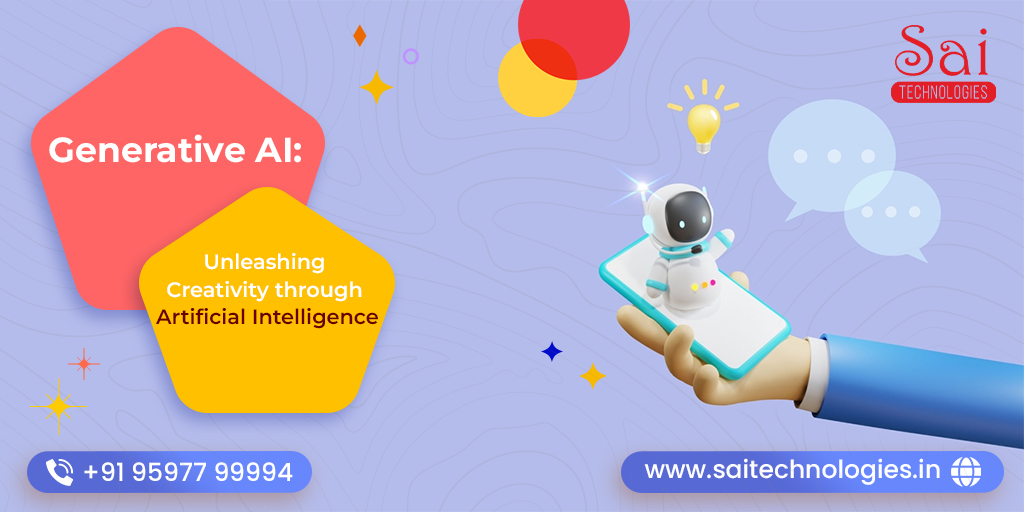Generative AI
Unleashing Creativity through Artificial Intelligence

Introduction:
In today's digital age, Artificial Intelligence (AI) continues to transform industries from healthcare to finance. One of the most exciting applications of artificial intelligence is Artificial Intelligence, a technology that has captured the imaginations of artists, designers and innovators. In this article, we dive into the fascinating world of Artificial Intelligence, exploring its capabilities, applications, and potential impact on future innovation.
Learn more about smart jobs
Generative AI, also known as creative AI or artistic AI, refers to the field of Artificial Intelligence that focuses on creating new content, such as images, music, text, and even all works of art. . Unlike traditional AI systems that are trained to perform specific tasks based on specified rules or data sets, artificial AI uses techniques such as neural networks and deep learning. to produce original and often unexpected versions.
How Artificial Intelligence works
At the heart of Artificial Intelligence are neural networks, computer models inspired by the structure and function of the human brain. These networks are layers of interconnected artificial neurons that process and analyze input data to produce an output. For next-generation AI, networks are trained on large amounts of data, such as images or text, to learn patterns and relationships.
After training, AI systems can generate new information by making inferences from learning patterns. For example, a synthetic AI model trained using face images can create new faces that are similar to faces in the training data but are completely unique.
Generative AI has great potential in a variety of applications:
Art and Creativity:
Artists and Designers are increasingly exploring artificial intelligence as a means of creative expression. By working with Artificial Intelligence systems, they can push the boundaries of traditional art forms and create new works that challenge our notions of creativity and authorship.
Content Creation:
Generative AI is revolutionizing content creation in industries such as marketing, entertainment, and gaming. AI-generated content, including images, videos, and music, can be used to enhance storytelling, engage audiences, and simplify the publishing process.
Personalization:
In E-Commerce, Artificial Intelligence allows for personalized product recommendations, customized ads, and customized user experiences. By analyzing user behavior and preferences, AI systems can generate content that appeals to each user, thereby increasing conversion rates and customer satisfaction.
Healthcare:
In Healthcare, Artificial Intelligence is used to generate medical imaging for training and research purposes. The Images created by Artificial Intelligence help medical professionals diagnose diseases, plan operations and develop better treatment strategies.
Fashion and Design:
Fashion designers use generative Artificial Intelligence to explore new design concepts, produce textile patterns, and create virtual fashion models. Intelligent design tools can simplify the design process, shorten time to market, and inspire new trends in the fashion industry.
Challenges and ideas:
Despite its potential, Artificial AI also raises various challenges and ethical considerations. A major concern is that AI-generated content may contain bias, as training materials may reflect trends or trends. In addition, there are issues related to intellectual property rights and the ownership of works created by AI, especially in the context of the arts and creative industries.
In addition, the rapid development of next-generation AI has raised concerns about its impact on jobs, as AI systems may replace or enhance human creativity in type of location. As AI technologies are implemented, efforts must be made to address these challenges and ensure that AI becomes a tool for positive innovation and social good.
The Future of generative Artificial Intelligence
Looking ahead, the future of Artificial Intelligence is full of exciting developments. As AI algorithms become smarter and easier to use, we may see innovations in creative fields from art and design to music and literature. Generative AI has the potential to accelerate creativity, allowing individuals and businesses to explore new ideas, solve complex problems, and unleash their creativity.
Exploring Artificial Intelligence applications:
Generative AI has driven interest and innovation in many areas with its ability to create original content in a variety of fields:
Art and Creativity:
Generative AI empowers artists to explore new techniques, styles and concepts, thereby reshaping the landscape of art and creativity. Artists collaborate with AI systems to create interactive installations, creative music compositions, and AI-assisted paintings. This collaboration blurs the lines between human and machine creativity, challenging our concepts of authorship and artistic expression.
Content Creation:
In the field of content creation, Artificial Intelligence is changing the way media is produced and consumed. Media companies are using AI-generated content to simplify production workflows, create personalized experiences, and engage audiences more deeply. From AI-generated content to virtual influencers, Artificial Intelligence is reshaping the media landscape and driving innovation in storytelling and audience engagement.
Design and Fashion:
Artificial intelligence is making waves in the world of design and fashion. Designers use AI tools to generate complex models, explore new trends, and create innovative design prototypes. In the fashion industry, Artificial Intelligence is used to predict trends, customize clothes and create virtual fashion models. Using the power of Artificial Intelligence, designers can push the boundaries of creativity and change the way you think about design and fashion.
Gaming and Entertainment:
The Gaming industry uses Artificial Intelligence to create immersive and dynamic gaming experiences. Game developers use AI-generated content to render realistic environments, render game levels, and even create AI-controlled and human-like characters. Artificial intelligence turns gaming into an interactive and personalized experience, where each game is unique and unique.
Healthcare and Medicine:
In Healthcare, Artificial Intelligence is used to generate synthetic medical images for training and research purposes. The Images created by artificial intelligence help medical professionals diagnose diseases, plan operations and develop better treatment strategies.
To conclude:
Generative AI represents a creative fusion of technology and creativity, providing new ways to think, innovate and reproduce ourselves. Using Artificial Intelligence, we can unlock the possibilities and shape the future of innovation in profound and meaningful ways.

